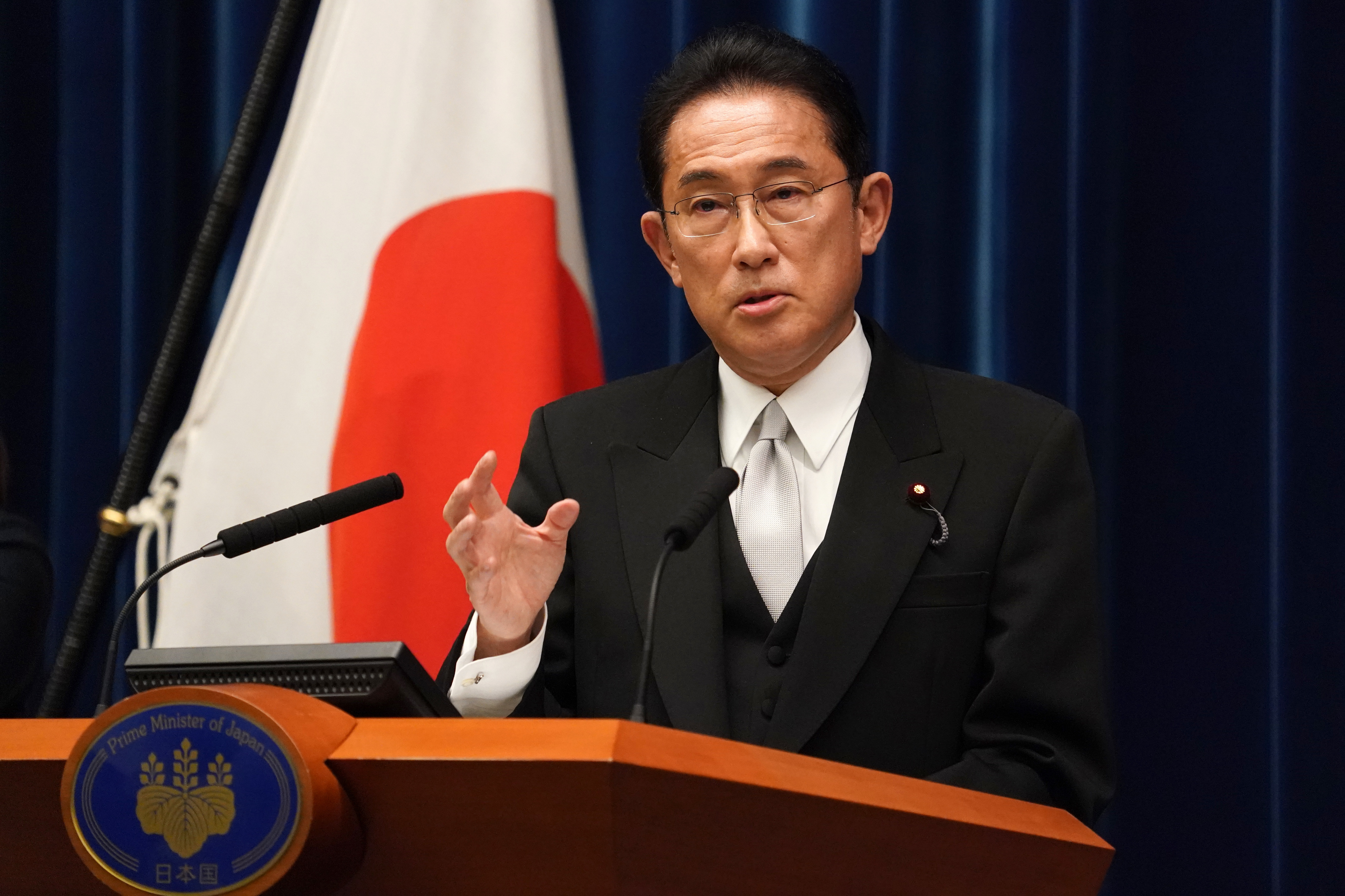- Article
- Tax & Social Security Reform
The Urgent Task of Lowering Japan’s Corporate Tax Rate
May 21, 2010
Japan must consider lowering its corporate tax rate, which is among the highest in the world, to protect jobs and address the needs of a graying population. EU member states have actually seen tax revenues rise by lowering corporate taxes and expanding the tax base, and this offers valuable hints on how Japan can proceed with its own tax reform.
1. The Need for Reform
Remarking in the Diet on March 12 that corporate tax rates “should rightly be guided lower,” Prime Minister Yukio Hatoyama hinted that he would launch discussions on reducing the rates. His Democratic Party of Japan had been criticized for lacking a growth strategy, so many welcomed the remark as the first bright news in a long time.
An international comparison of nominal and effective corporate tax rates reveals that the statutory rate in Japan and the United States are around 40%, some 10 percentage points higher than other industrial countries (Figure 1). This, as will be described below, is the result of repeated efforts by countries other than Japan and the United States to lower their rates and attract foreign businesses.
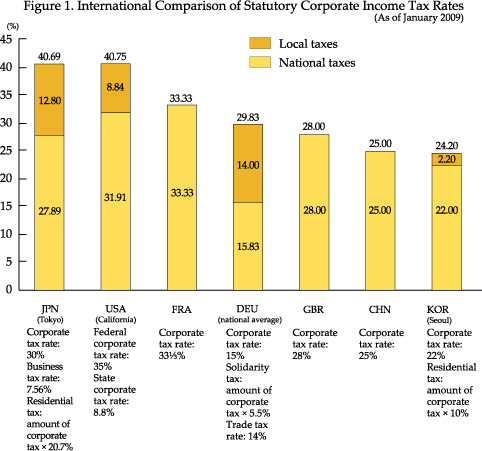
The general feeling in Japan is that there is no need for lower rates since they are on a par with the United States. But this is quite misleading, for a look at the effective tax rate (corporate taxes as a share of pretax income) in Japan and the United States reveals that it is nearly 10 points lower in the United States.
Why is this so when the statutory rates in the two countries are essentially the same? Part of the reason is that in the United States, taxable profits are calculated according to a different set of rules from those used in the calculation of profits in financial statements, but a much bigger factor is the aggressive tax planning efforts made by US businesses.
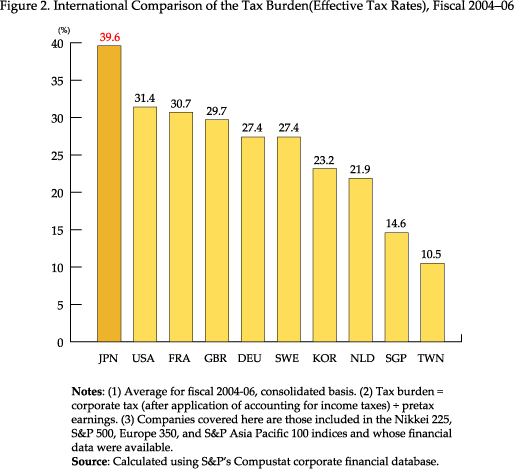
An increasingly popular method of transferring income is to establish an intangible property company (IPCO) in a low-tax country to collect and manage royalties from the licensed use of intellectual property rights, which are a major source of income for many businesses. Multinational pharmaceutical and beverage companies receive huge sums for the use of registered patents and trademarks, and many of them now retain such profits in low-tax countries.
Even among Japanese companies, there is a growing trend to view taxes as costs, particularly with the rise in the share of foreign shareholders and such deregulatory moves as amendments to Japan’s Companies Act. Some are transferring or retaining their income in low-tax countries, leading to the drain of the country’s added value and the loss of employment and tax revenues. Under the tax system revisions of fiscal 2009, income that had been retained by an overseas subsidiary can now be transferred back to Japan tax-free, but this has the possibility of actually encouraging more companies to retain their earnings at their foreign subsidiaries.
This is not difficult to foresee when one looks at the partner countries of Japan’s foreign direct investment and inward direct investment (Figure 3). The country with the largest balance of direct investment in Japan was the United States, as of the end of 2006. In second place was the Netherlands, with the Cayman Islands coming in fourth and Singapore seventh. As for Japan’s direct investment in other countries, the list was topped by the United States, followed, similarly, by the Netherlands in second place, the Cayman Islands in fifth place, and Singapore in seventh place. Both the Netherlands and Singapore offer preferential tax rates as a way of attracting foreign capital, and many companies in the industrial world are evidently conducting their investments via these countries. The Cayman Islands are famous as a tax haven. This shows that direct investment to and from Japan is already being conducted via low-tax countries and also that the tax system is a major factor in investment decisions today.
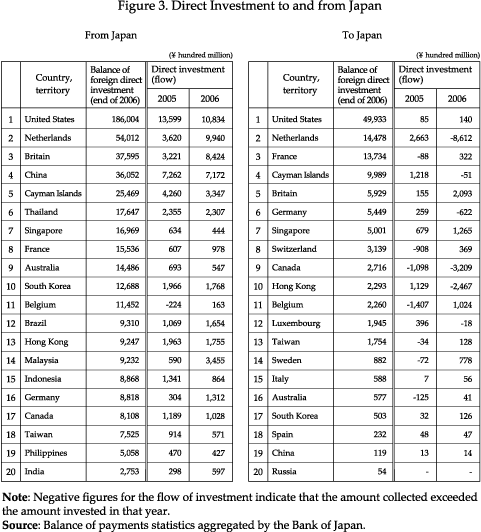
To protect jobs in the face of international competition and to finance the necessary costs of an aging population despite a falling birthrate, Japan must not only prevent domestic companies from moving abroad but also attract greater foreign direct investment from other countries. This state of affairs is the chief reason and offers ample justification for lowering the corporate tax rate. Most arguments for a lower tax burden to date have focused on the impact it would have in encouraging capital investment and economic activity. The international competitiveness argument is more compelling; Germany, for instance, has been implementing corporate tax reform to enhance the competitiveness of operating in the country and to reclaim the tax revenue that that had been flowing to the Netherlands and Ireland.
2. Essence of the Tax Reduction Race
The Organization for Economic Cooperation and Development has published the results of an interesting study on the correlation between tax competitiveness and tax revenues.
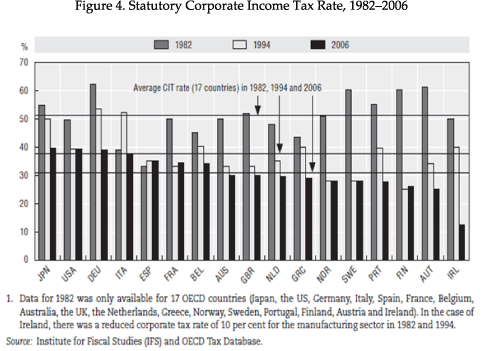
The closer integration of the European Union has engendered an extremely fierce race for lower corporate taxes among the member states over the past decade, with the tax rate declining by several points, as mentioned above. East European states lowered their rates in an attempt to attract German and French businesses and expand employment. This incited a “race to the bottom,” as the West European states reacted with lower rates of their own to keep domestic companies at home and to attract foreign ones. Figure 4 shows how the rates have declined over this period.
The OECD study shows, though, that while the EU member states have been cutting their corporate tax rates, corporate tax revenue as a percentage of gross domestic product has actually been rising. This seemingly paradoxical relationship between corporate tax rates and tax revenues has elicited great surprise and interest among the member states.
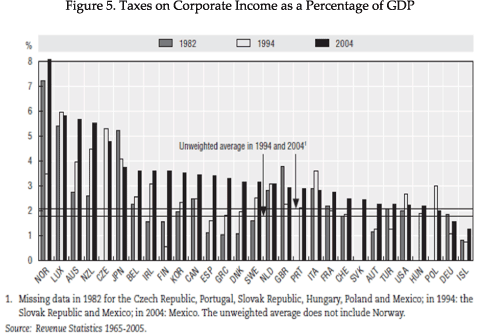
Figure 5 shows taxes on corporate income as a percentage of GDP. indicating that the percentage rose from 1994 to 2004. Corporate tax revenue as a share of total tax revenues (Figure 6) has also risen between 1994 and 2004.
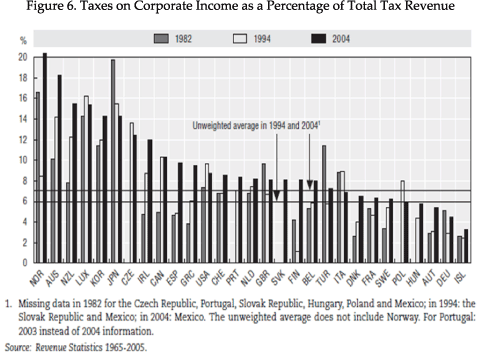
Why have lower tax rates resulted in higher revenues? The OECD report and researchers in the EU point to the following factors. They have analyzed trends in all member states by identifying three components of the tax-revenue-to-GDP ratio.
The first component is what is called the effective tax rate, which has remained relatively steady in most countries. It is this component that has been most affected by the lowering of corporate tax rates and the accompanying expansion of the tax base.
The second component is the corporate share of all added value in the economy. This percentage has been rising gradually in many countries, which is believed to have been caused by a shift from the personal sector to the corporate sector owing to the lower tax rates of the latter.
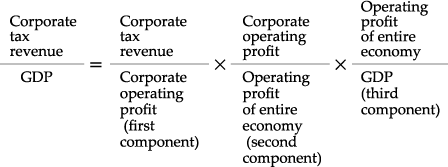
The third component is corporate profits as a share of GDP, which rose in many countries during the first decade of the millennium. This has been explained as a reflection of the many new companies that individuals established stirred by the spirit of entrepreneurship.
This analysis has produced two major conclusions. The first is that in many countries, corporate taxes were lowered together with an expansion of the tax base, such as through a reexamination of special tax measures and depreciation methods. This approach is typified by the taxation reforms carried out in Germany and Britain.
The second conclusion is that the tax-cutting race seen during the past decade resulted in an increase in business start-ups. The lower tax rates gave people incentive to start their own business, offering empirical proof of vitalized economic activity.
3. Steps to Follow
Debate on reforming the tax system is likely to begin in Japan as well. The links between corporate tax rates and business behavior is quite complex, though, with the statutory rate believed to affect the overseas transfer of profits and the effective rate influencing investment decisions. The Hatoyama administration has announced it is freezing the consumption tax rate for at least four years, so the prospects of a lower effective tax rate within the framework of reforms for the tax system as a whole remains rather opaque.
Given such murky prospects, it may be a good idea to first reform the corporate tax system and lower the tax rate, combined with an expansion of the tax base. Because such reforms would be tax neutral and result in lower rates, there should be little resistance from the general public. They may have the added benefit of encouraging entrepreneurship—invigorating economic activity and leading to higher tax revenues, as was seen in the EU—and of dampening corporate plans to shift operations to low-tax countries.
Ways of expanding the tax base include reexamining the special tax treatment now available in some cases; shifting the method of tax depreciation from one based on fixed rates to that on fixed sums; placing limits on deductions for interest payments, and abolishing preferential rates for stock transactions.
The next step would be to lower the effective corporate tax rate as part of comprehensive reforms that would also include the consumption tax. There would be a need to cover any revenue shortfalls resulting from a lower effective corporate tax burden, so any adjustments would have to be considered in conjunction with discussions of a consumption tax hike.
The reluctance to reforming corporate taxes comes from the perceived individual-corporate dichotomy. It should be remembered, though, that businesses and individuals are on the same boat and in a state of mutual dependence. In their capacity as employees, creditors, and shareholders, individuals are provided with the added value generated by businesses in the form of wages, interest, dividends, and capital gains. Thus, corporate tax reform in Japan would not be aimed at helping Japanese business firms but at enhancing the competitiveness of basing corporate operations in Japan and of generating the necessary revenue to address the graying of the population. An early start to the tax reform debate would be most welcome.

















